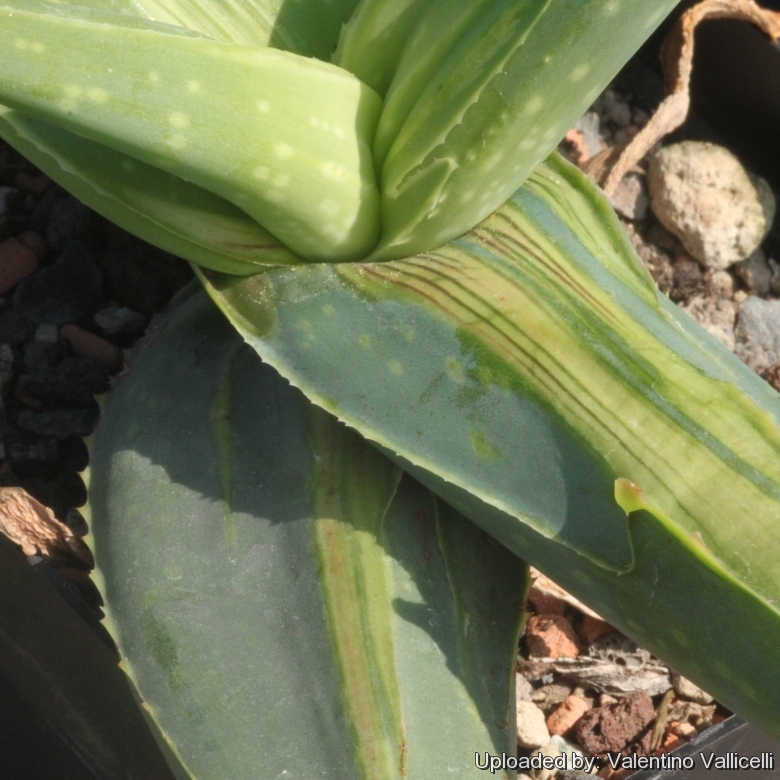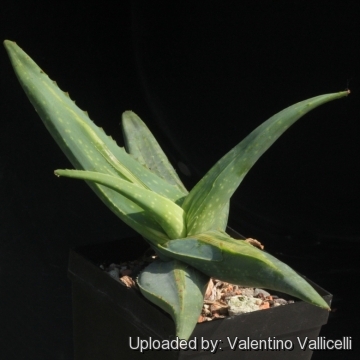
Aloe striata f. monstruosa variegata Photo by: Valentino Vallicelli
Origin and Habitat: Garden origin
Synonyms:
See all synonyms of Aloe striata
Description: This is a fantastic odd aloe with broad monstrous blue-green leaves with yellowish-green and reddish-brown stripes. It appears to be quite different from the standard Aloe striata and seems derived from seed of plants grown in cultivation, which tend to hybridize with other Aloes in the garden, as suggested by the spiny edges. It grows almost always as a single stemless rosette, usually about 25 cm tall and 45 cm diameter, older specimens may develop a short trunk.
Subspecies, varieties, forms and cultivars of plants belonging to the Aloe striata group
 Aloe striata f. monstruosa variegata Photo by: Valentino Vallicelli
Aloe striata f. monstruosa variegata Photo by: Valentino Vallicelli Aloe striata f. monstruosa variegata Photo by: Valentino Vallicelli
Aloe striata f. monstruosa variegata Photo by: Valentino VallicelliCultivation and Propagation: It is is an interesting succulent easy to cultivate under a wide variety of climatic conditions provided it is planted in a well-drained situation given adequate water but not over-watered. In cultivation it can tolerate more water - but when over irrigated or in heavy soils the leaves will split open.
Growth rate: It is pretty fast grower and appreciates a lot of water in warmer weather. Even young plants grow fairly quickly in the garden or in good sized pot.
Soil: Well-de-composed compost addition to well draining sandy-gritty mix creating a rich soil is advantageous.
Pots: It needs a relatively shallow pot to accommodate its fibrous roots and provide a very good drainage. It may stay in the same pot for many years.
Watering: Water aloes more than other succulents, keeping in mind that the pots dry out between watering. Keep dry in winter or when night temperatures remain below 10° C. Water it less than average if in bigger pots. They are really not very demanding and regular watering in their growing season creates healthy disease resistant plants that will flower better.
Special need: Provide very good ventilation. Nearly all problems occur as a result of overwatering and poor ventilation, especially when weather conditions are dull and cool or very humid.
Fertilization: Light fertilizer seems to boost its growth whenever additional water is given. Feed it during the growing season with a fertilizer specifically formulated for cactus and succulents (high potash fertilizer with a dilute low nitrogen), including all micro nutrients and trace elements diluted to ½ the strength recommended on the label. It thrive in poor soils and needs a limited supplies of fertilizer to avoid the plant developing excess vegetation, which is easily attacked by fungal diseases.
Exposure: It will do its best in full sun to light shade and become stressed with inadequate light which could result in poor growth and unnatural shape. Will handle harsh sunlight, sometimes taking on a coppery leaf sheen, a sign generally associated with stress.
Hardiness: It is a hardy aloe but not completely frost resistant, but for safe cultivation it is best to avoid freezing temperatures. USDA Zone 9.
Use: It can be cultivated outdoors in raised beds and terraces and in big pots as well.
Maintenance: Removal of old flower stalks.
Propagation: Propagation is from offsets. It is easily rooted in potting soil at 18°C.












